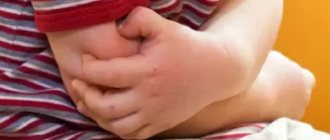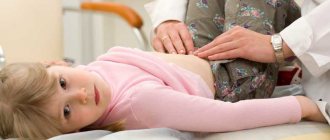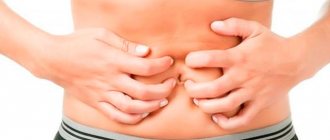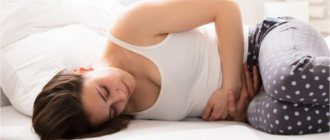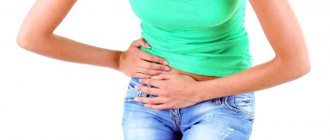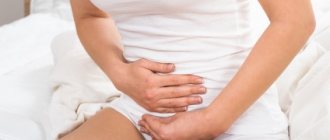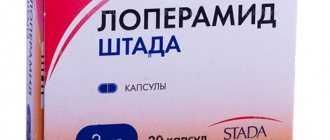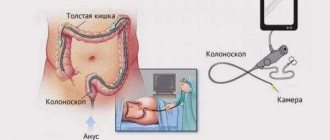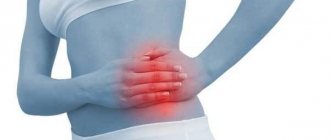Abdominal pain is one of the most unpleasant. Because when we experience this feeling, it is impossible to do anything, even walking can sometimes be difficult. But how bad it is for a little man when he experiences pain in his tummy. Especially in those cases when he cannot really explain where and how it hurts. Most often, children complain of discomfort in the navel area. Pain in the navel in a child is a symptom of a serious illness. Therefore, parents should under no circumstances ignore this situation.
Causes of pain in the navel area in a child, symptoms of disease
The children's digestive system is formed as the child grows, and therefore it is not always able to cope with the difficulties that arise. Therefore, sometimes pain occurs in the navel area as a result of introducing new foods into the diet or changing the diet.
But this is not always the only reason. Serious illnesses can also provoke pain, so you should not ignore your child’s complaints.
Colic
This phenomenon is caused by spasms of the muscle tissue of the gastrointestinal tract. As a result, acute pain occurs, causing severe discomfort. The child grabs his stomach, tries to lie down and take a position that will ease the unpleasant sensation.
Colic up to 1 year of age is a natural process. This occurs when the digestive system adapts to the introduction of new foods into the baby’s diet. To relieve symptoms, special medications are used on the recommendation of a pediatrician.
But if an older child complains of spasms, then this is a sign that a malfunction has occurred in the body. In this case, the attack can be both long-term and short-term. In this case, it is worth trying to find out exactly where the pain is felt and how intense it is before the doctor arrives.
Pain due to bloating
Pain occurs when intestinal gas accumulates, causing intestinal distension. This is a natural phenomenon in children. And in older children, the cause of bloating may be overeating and the increased content of fats, proteins and carbohydrates in the diet is incommensurate with age-related development.
Sometimes the cause of increased flatulence is stress and anxiety. As a result, the tone of the intestinal muscle tissue increases, and the spasm interferes with the normal passage of masses through the digestive organs, and as a result, their fermentation begins and gas is released.
Seasickness
Pain in the navel area in a child can be caused by an attack of seasickness during a trip. This occurs as a result of motion sickness when balance and balance are disturbed during movement. Abdominal pain is accompanied by nausea and dizziness. Upon arrival at the destination, the unpleasant symptoms disappear.
To reduce the likelihood of their development, it is worth planning a trip with stops, which will allow the child to breathe fresh air.
Bacterial dysentery
The cause of pain is the colonization of the intestines by pathogens. Infection occurs through contact with an infected person, as well as through consumption of unwashed fruits and dirty water.
Pain in the abdominal cavity is combined with:
- diarrhea;
- vomiting;
- frequent urge to go to the toilet.
The stool contains mucous and blood impurities. The pain periodically intensifies and subsides. Prevention - following the rules of personal hygiene.
Viral infection
Pain in the navel area in a child can manifest itself as one of the symptoms of a viral infection of the body. Most often it is combined with fever, vomiting, nausea and diarrhea.
With hepatitis A, pain is localized in the upper right corner of the abdomen, which indicates liver damage. A characteristic sign of pathology is yellowness of the skin.
Cough and sore throat due to streptococcus
A sore throat caused by streptococci can also cause pain near the navel. This is due to the fact that when coughing, the child strains the abdominal muscles, causing them to overstrain. Additional symptoms are headache, cough, fever, and sore throat.
Abdominal tuberculosis
The pathology affects the lymph nodes of the small intestine, peritoneum and retroperitoneal space, which provokes pain.
Discomfort manifests itself in combination with general symptoms of intoxication:
- frequent vomiting;
- pointed facial features;
- bloating;
- increased thirst;
- sudden weight loss;
- high body temperature.
Infection occurs through contact with a carrier of the infection. The child's immune system is not able to resist the pathogen.
Constipation
This is a common cause of abdominal pain. Constipation is a disorder of the intestines, which is expressed in an increase in the interval between bowel movements or insufficient bowel movements.
Characteristic symptoms:
- the pain manifests itself in attacks, and within 10-30 minutes. disappears;
- the pain can be mild and unbearable;
- the process of defecation is difficult;
- excrement has a hard and dense consistency;
- The child has stool once every few days.
The presence of these symptoms confirms that the pain is caused by constipation.
Lactose intolerance or milk protein allergy
Pain in the navel area in a child in this case is the body’s reaction to an intolerable component: in the first case - lactose, in the second - milk protein. These pathological processes are manifested by a feeling of discomfort in the abdomen.
Characteristic symptoms:
- increased cramping after eating dairy products;
- bloating;
- colic in the intestines;
- diarrhea;
- pain is felt throughout the abdomen.
Diarrhea
The pathology is manifested by loose stools with frequent urge to go to the toilet. Often, diarrhea is a symptom of a viral, bacterial and infectious lesion. Accompanied by pain in the navel and characteristic rumbling.
Heartburn, gastritis and ulcers
These pathologies of the digestive organs develop as a result of damage to the mucous membrane, and are characterized by a burning sensation in the upper and central part of the abdomen, as well as behind the sternum.
In addition to pain, the pathological process is accompanied by:
- feeling of fullness in the stomach;
- bitterness or acidity in the mouth;
- increased pain when bending over and lying down.
Parasites
No matter how carefully parents monitor their child’s hygiene, the likelihood of infection with parasites is very high. As a result of his curiosity, the child tries not only to touch new objects, but also to taste them.
Pain in the navel area in this case manifests itself against the background of bloating and accumulation of helminth waste products. Associated symptoms are diarrhea, itching near the anus, and intestinal spasms.
Dyspepsia (digestive disorder)
Acute pain in the navel area, intensifying with inhalation, is a sign of the development of dyspepsia. The course of the disease directly depends on the quality and quantity of food consumed. The provoking factor is a violation of the diet, regular undereating and overeating, overheating of the baby, and the discrepancy between the amount of food consumed and the child’s age.
Abdominal pain with dyspepsia is combined with the following symptoms:
- diarrhea of a greenish tint, emitting a foul odor;
- frequent urge to go to the toilet;
- lack of appetite;
- weight loss;
- thirst;
- temperature 38-39 degrees;
- increased flatulence;
- general weakness.
Appendicitis
This pathology is a common cause of acute abdominal pain, which is initially localized in the navel area and then moves to the lower right side of the abdomen. When discomfort occurs, the child tries to lie down, curl up and tuck his legs. Anxiety increases with changes in body position. If these signs appear, call an ambulance.
The main symptoms confirming inflammation of the appendix:
- nausea;
- chills;
- dry mouth;
- vomit;
- pain in the stomach;
Inflammation of the appendix causes abdominal pain in the navel area in a child
- elevated temperature.
Urinary tract infections
The cause of inflammation is bacteria that penetrate the kidneys and urinary tract. Children who do not observe the rules of personal hygiene, with reduced immunity, an unbalanced diet and congenital anomalies of the urinary tract are susceptible to pathology. The provoking factor is hypothermia, sitting in the cold, putting on wet underwear.
In addition to pain in the navel area, the following symptoms appear:
- pain when urinating;
- frequent urge to go to the toilet;
- decrease in the volume of urine excreted;
- general malaise;
- sleep disturbance;
- irritability;
- the shade of urine becomes cloudy and dark.
Intestinal obstruction
A feeling of discomfort is a symptom of concomitant diseases in the body. During the period of exacerbation, not only pain appears, but also flatulence as a result of the accumulation of feces in the intestines. Often, obstruction is accompanied by rapid vomiting, which has a green tint due to the presence of bile.
Intussusception
The pathology is characterized by the penetration of the intestine into the underlying loop of the intestine. As a result, 2 cylinders are formed - inner and upper. The situation is worsened by a significant narrowing of the lumen, which reduces blood circulation in the strangulated intestine.
The provoking factor is the introduction of complementary foods ahead of time, as well as a significant excess of the amount of food for a given age. Pain in the navel area in a child is the main symptom of intussusception. It alternates with periods of relief. Bloody stool may appear.
Medications
Sometimes the pain is caused by the use of medications. Therefore, parental observations of the child’s condition and the development of the medical history are important. Antibiotics are often the cause of pain.
Irritable bowel syndrome
The disease develops as a result of digestive dysfunction in the colon as a result of poor diet, frequent snacking and eating habits.
In addition to pain, other signs appear:
- quick satiation with food;
- belching;
- nausea;
- presence of mucus in feces;
- increased discomfort during palpation.
The pain goes away at night.
Menstrual cramps
The cause of pain in teenage girls may be cramps associated with menstruation. In this case, the pain syndrome can manifest itself several days before their onset. A physiologically active substance, prostaglandin, provokes the appearance of spasms during this period. A nagging pain is felt not only in the lower abdomen, but also in the lumbar region.
Psychological factor
A child may also feel pain in the abdomen due to the characteristics of their psychological state. The main reason may be the desire to attract the attention of parents. At the same time, the child believes in it so much that he really begins to feel pain. Often this behavior of a child is caused by the appearance of a second child in the family.
Another psychological factor is anxiety due to stressful situations. In this case, the child feels colic, which is combined with diarrhea. After eliminating stress, the pain goes away on its own.
Umbilical hernia strangulation
The pathology develops against the background of a weakening of the muscle tone of the umbilical ring. As a result of this, part of the peritoneum and intestinal loops protrude in the child’s abdomen, which is a hernia. The provoking factor is heredity, prematurity, hypothyroidism, rickets, Down syndrome.
During treatment, a wait-and-see approach is used, since muscle tone is able to recover on its own. Physical activity and normalization of intestinal function accelerate the process.
Enterocolitis, gastroduodenitis, Crohn's disease, ulcerative colitis
In this group of diseases, the functionality of the intestine is impaired. The reason for this may be poor nutrition, food poisoning, exposure to bacteria, or congenital anomalies.
General symptoms:
- diarrhea followed by constipation;
- feeling of insufficient emptying after visiting the toilet;
- belching;
- flatulence;
- pain in the navel area;
- mucus in feces.
Other causes of abdominal pain in children
Pain in the navel area in a child may occur due to the development of other diseases. It is important that parents are able to track their medical history, which will allow them to establish the main cause of the discomfort.
Pathologies accompanied by abdominal pain:
- mononucleosis;
- abdominal migraine;
- neoplasms in the organs of the digestive system;
- pancreatitis;
- cholelithiasis;
- celiac disease.
Abdominal pain in a young child can be identified by changes in his behavior, irritability, tearfulness, and sleep disturbances. But teenagers do not always admit to discomfort, so parents should pay attention and notice any changes in their behavior, since sometimes delay can lead to serious health complications.
Colitis.
If a child has pain to the left of the navel, then it is likely colitis - inflammation of the rectum or sigmoid colon.
Pain from colitis is usually not very acute, but long-lasting. Flatulence develops (bloating due to the accumulation of gases), and frequent loose stools mixed with blood appear.
It is important to consult a doctor in time for colitis to prevent the disease from becoming chronic.
Pain in the navel area in a child can occur for various reasons, but in any case, parents should be extremely attentive to this symptom. Be healthy!
Diagnostics
The appearance of pain in the navel area can be due to various reasons. Therefore, it is important to establish a diagnosis that parents can talk about possible events preceding the discomfort. The doctor analyzes the information received and compares the data with the studies performed. This allows us to make a final conclusion about the cause of the pain.
Additional research:
- Analysis of urine;
- stool examination;
- blood analysis;
- X-ray;
- CT;
- irrisgoscopy;
- sphincterometry.
In some cases, additional consultation with a pediatric surgeon and gastroenterologist is required. After collecting all the data, a diagnosis is made and treatment is prescribed.
First aid for pain
It is not recommended to give medications for abdominal pain if this symptom intensifies or does not appear for the first time. If the pain is very acute, you need to stop feeding or watering the baby, you should provide him with complete rest until the doctor arrives.
If the cause is intestinal colic from food, constipation or another identified pathology, you can do the following:
- Put the child to bed, wrap him in a blanket. If your newborn is sick, you can hold him in your arms.
- After consulting with a doctor, give a cleansing enema.
- Folk remedies such as dill water or fennel decoction will help relieve bloating and flatulence.
- If the doctor has given permission, they give products with simethicone (Espumizan).
A gentle massage of the abdomen in a clockwise direction will help get rid of excess gas and colic.
First aid should not be delayed for several days if unpleasant pain in the abdominal area persists for a long time. Parents should discuss any actions with the doctor, even if a personal visit is not possible or the specialist is on the way.
Treatment of abdominal pain
The course of therapy depends on the established cause of the pathological process. Abdominal pain caused by a simple malfunction of the digestive system can be treated at home in consultation with the attending physician.
It is important to ensure bed rest, dietary nutrition, and plenty of fluids. If necessary, medications are used, as well as folk remedies as a supplement to enhance the therapeutic effect.
Bed rest
In the lying position, the unpleasant sensations weaken. Therefore, it is necessary for the child to be at rest. Sometimes lying on the stomach, the pain goes away, but you cannot insist on this; the child himself must decide how to lie down to make it feel better.
Fluid intake
Abdominal pain is most often accompanied by diarrhea and vomiting. This leads to dehydration of the body. To restore water balance, give the child water every 20-30 minutes. in small portions. For drinking, use not only clean water, but also electrolyte solutions sold in pharmacies. They will help restore the alkaline balance.
As a drink, you can use broths and decoctions of medicinal herbs (chamomile, St. John's wort). If a child asks for a carbonated drink, it is recommended to release some of the gas in advance. They should not contain caffeine or other components that irritate the mucous membrane of the digestive organs.
Diet
During the treatment period, you should not insist on eating; the child himself will let you know when he has an appetite. At the same time, it is worth excluding difficult-to-digest foods, tomatoes and fatty foods from the diet.
Recommended for use during the recovery period;
- boiled rice;
- applesauce;
- chicken bouillon;
- cracker;
- banana.
When the child gets better, he himself will ask for more nutritious food.
Medications
Give medicine to a child only as prescribed by a doctor. Antispasmodics should not be used until the cause of the pain has been established. This is due to the fact that they blur the clinical picture and can cause an erroneous diagnosis.
Acceptable drugs to eliminate unpleasant accompanying symptoms:
| Medicines | Application |
| "Disflatin", "Espumizan" | with bloating |
| "Laktovit", "Linex", "Gastrolit" | for diarrhea |
| "Mezim", "Festal", "Creon" | when overeating |
| "Atoksil", "Smecta", "Enterodes" | with food intoxication |
| "Renny", "Almagel", "Maaloksom" | for heartburn |
| "No-shpa" | universal for spasms |
| "Paracetamol" | at elevated temperature |
Self-medication is strictly prohibited, and Acetylsalicylic acid should not be used to reduce fever.
https://youtu.be/nkJMOB9GB0o
Folk remedies
This treatment method is an addition to the main therapy.
It is worth using folk remedies if your doctor has approved their use:
- Chamomile decoction . 20g of collection pour 1 tbsp. boiling water, leave for 40 minutes. Give the child a drink of 50 ml every 4 hours. Continue the course of therapy until the pain is eliminated. The antibacterial and anti-inflammatory properties of chamomile help eliminate unpleasant symptoms.
- Natural yogurt. The beneficial bacteria in the product help eliminate constipation and normalize intestinal function. Use the product 2 times a day.
- Warmer. Dry heat has a relaxing effect on the abdominal muscles. This helps activate blood circulation and eliminate pain. You can use a heating pad if there is no inflammation in the abdominal cavity.
What can you eat?
When experiencing pain in the abdomen, heavy foods should be avoided. Overfeeding is also harmful for the restoration of the body. Food should be light and easily digestible. Bananas, boiled rice, applesauce and crackers will be useful during this period. Gradually it will be possible to switch to a normal diet. It is better to divide a standard portion into several doses and feed the child every 2-3 hours. Vegetables and fruits that contribute to the formation of gas should be excluded from the diet.
Pathology can appear from the first days of life with improper care or feeding. The disease also develops as a result of taking antibiotics, overusing fatty foods, and the penetration of pathogenic bacteria into the gastrointestinal tract.
Dysbacteriosis is manifested by monotonous pain around the navel, bloating, bad breath, and in infants - vomiting and regurgitation, unstable stool. Symptoms of the disease may include diarrhea or constipation.
The treatment of dysbiosis should be approached with caution: incorrectly selected drugs can disrupt the microflora. A mild stage of the pathology can be eliminated at home, but in its acute form, dysbiosis can only be treated in a hospital setting.
Appendicitis
Inflammation of the appendix makes itself felt by dull pain in the navel area on the right side. They are accompanied by vomiting, bloating, and painful sensations when urinating. The child feels sick and has a fever and refuses to eat.
No matter how old the child is, parents must act very quickly. You cannot hesitate: urgent surgical intervention is required, otherwise the disease may result in peritonitis.
Umbilical hernia
Before the age of one year, every fifth baby is at risk of developing this disease. The pathology is easy to diagnose: the navel protrudes and rises above the surface of the abdomen. At 3 years, and sometimes even by 5 years, the hernia disappears on its own. However, doctors still recommend measures to eliminate it: a special patch and therapeutic exercises. Read the article about the main methods of treating an umbilical hernia.
Intestinal hernia
This is a protrusion of intestinal loops through weak spots in the abdominal cavity. The disease is manifested by nausea, vomiting, and stool upset. During palpation, protruding intestinal loops and various seals are felt. Treatment of a hernia consists of diet, exercise and massage.
Food poisoning
Intestinal disorders to varying degrees can occur after eating low-quality food. Mild poisoning makes itself felt by nausea, diarrhea, and pain in the navel. In severe cases, the temperature rises, vomiting and diarrhea develop. Severe intestinal infections must be treated in a hospital. Read the article about first aid for food poisoning.
Enteritis
This is the name for inflammation in the small intestine, which is accompanied by dystrophic changes in its mucosa. The disease is characterized by bloating, pain in the navel, deterioration of health and weight loss. It is advisable to treat enteritis in a hospital.
Abdominal migraine
Hearing this name, parents wonder what kind of disease it is. This is the name for a pathology that manifests itself as severe headaches and discomfort in the navel area. The disease can occur due to stress and emotional overload.
If everything is fine with the digestive organs, the child is referred for examination to a neurologist. Most often, children aged 7–8 years are susceptible to the disease, when school age begins and the child cannot cope with the increased load.
Volvulus
This is the name for stool obstruction as a result of rotation of one of the intestinal sections. Most often, the pathology is observed in babies under six months. It is manifested not only by abdominal pain, gas formation, intestinal motility and blood pressure decrease.
Stones in the kidneys
If your baby has pain just below the navel, it is likely that he has stones coming out of his kidneys. They are formed as a result of an incorrect diet: fatty foods, an abundance of spices. Pain when stones pass from the kidneys radiates throughout the entire peritoneum. To find out the diagnosis, you will have to do an ultrasound examination of the bladder. Treatment is individual depending on the stage of the disease.
Inflammation of the lymph nodes in the peritoneum
Inflammation of the lymph nodes is accompanied by peri-umbilical pain, fever, and nausea. The child bends his legs, trying to find a position in which the discomfort will be less noticeable. Treatment is carried out in a hospital using antibiotics and other medications.
These are the most common causes of pain in the peritoneum, which affect children under 10 years of age. Among the less frequent reasons it is worth mentioning:
- pneumococcal peritonitis in girls;
- coprostasis (constipation);
- tuberculous mesadenitis;
- intussusception;
- acute diverticulitis (inflammation of the bile duct);
- developmental anomalies and pathologies of the gallbladder and others.
Pathological conditions should not be joked about: if the pain becomes acute, especially at night, you should immediately call an ambulance.
When is medical intervention necessary?
Pain in the navel area is sometimes one of the symptoms of a serious complication in a child. Sometimes the clock is ticking, so any delay can be fatal.
Associated symptoms requiring immediate medical intervention:
- diarrhea, vomiting in a child under 3 years of age;
- sharp, sudden pain in the abdomen;
- vomiting without stool;
- blood impurities in feces;
- the abdomen is hard, severe pain is felt upon palpation;
- breathing problems;
- abdominal trauma;
- painful urination;
- pain in the groin, scrotum, ovaries.
Pain in the navel area most often manifests itself against the background of a child’s eating disorder, as well as as a result of non-compliance with basic rules of personal hygiene.
To prevent the development of a pathological process, parents should teach their child to regularly wash their hands after a walk, before eating, contact with animals, and to eat only clean fruits and vegetables. These simple rules significantly reduce the likelihood of diseases of the digestive system.
Article design: Mila Friedan
Errors in localization
Only a doctor can accurately determine the location of the most painful area with gentle palpation of the abdomen. At this time, it is decided where exactly the sore spot is located: above the navel, slightly below or almost above the pubis, on the right or left.
At the same time, the doctor tries to determine the edge of the liver and spleen, checks the symptoms of appendicitis in the typical and atypical position of the appendix. Parents and teachers should take this into account when figuring out why a child has a stomach ache near the navel.
Teenage girls should be shown to a pediatric gynecologist. Their abdominal pain is associated with the period before or during menstruation, and also accompanies endocrine diseases with delayed sexual development.
Teenage boys are at risk for Crohn's disease. Especially if cases have already been discovered in the family. Paroxysmal contractions along the intestines appear during an ulcerative process and can cause a covered perforation into neighboring loops of intestines and the bladder.
The most frequently detected pathologies in children
In childhood, it is extremely rare for chronic pathology to develop. The most common causes of diseases with pain around the navel are:
- functional digestive insufficiency;
- poisoning from poor-quality products, “adult” food;
- transition to artificial feeding and intolerance to certain foods;
- helminthic infestation;
- intestinal infection;
- inflammatory diseases;
- developmental anomalies.
Enteritis
A group of inflammatory bowel diseases. They can be caused by rough food, allergies, intestinal infections and parasites. Children complain of pain around the navel, refuse to eat, vomiting, nausea, rumbling in the stomach, and frequent loose stools occur.
https://youtu.be/yZ-I8PkamQw
Infants with inappropriate complementary feeding often experience regurgitation of large, curdled flakes. Intolerance is accompanied by allergic manifestations: rashes on the cheeks, in the bends of the arms and legs, on the body, itchy skin. An increase in temperature and loose stools mixed with greens indicate the addition of an infection.
The child quickly becomes dehydrated. The skin begins to peel due to dryness. Enteritis always disrupts the absorption function, so children are behind in weight, lose vitamins, and develop poorly.
Therapy involves mandatory testing of stool for pathogenic microorganisms, adherence to a diet and the use of antibiotics.
Dysbacteriosis
The condition develops against the background of long-term treatment of the child with medications, especially those with an antibacterial effect. In the intestinal flora, the first to die are bifidobacteria and lactobacilli, which normally account for up to 95% of all beneficial microorganisms.
This mechanism occurs during the period of recovery from an infectious disease, influenza, or viral pathology. The child feels heaviness in the stomach, diarrhea or constipation appears, and sometimes cramping colic around the navel. It is necessary to use probiotics and their assistants – prebiotics.
Diagnostic methods
Diagnosis of the causes of abdominal pain can be carried out as planned in a children's clinic (we recommend reading: causes and methods of eliminating pain in the left side of a child). If the child’s condition has deteriorated significantly and the pain does not go away on its own, examinations are carried out in a hospital. Doctors often prescribe:
Based on the results of the examination, the pediatrician decides which specialist to refer the child for treatment. The gastroenterologist prescribes a therapeutic course. If problems were discovered in areas other than the gastrointestinal tract, then a nephrologist, hepatologist, neurologist and infectious disease specialist are involved in the treatment.
https://youtu.be/NeldrFxS5kU
